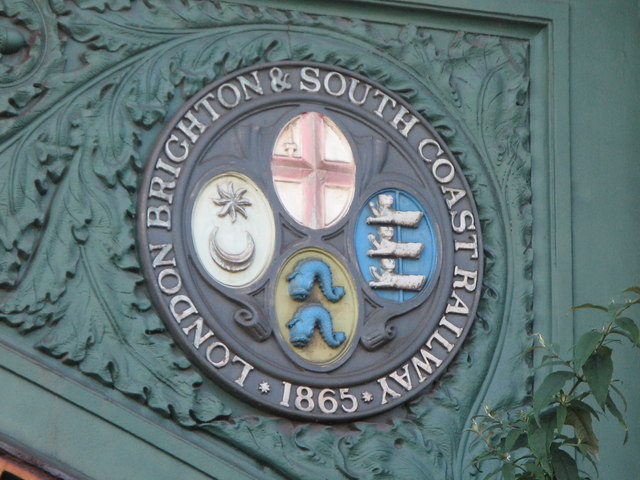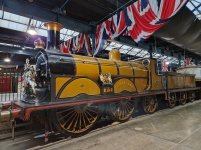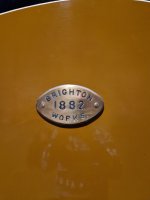Sorry for the massively geeky and off topic post, but saw the below at the National Railway Museum in York yesterday and have always been amazed how what was once one of, if not the biggest industries in the city is now almost unknown. Does anyone have any family history with the place or stories to tell? I realise it all closed down quite some time ago. It just seems amazing to think of something like this being built in Brighton.
You are using an out of date browser. It may not display this or other websites correctly.
You should upgrade or use an alternative browser.
You should upgrade or use an alternative browser.
[Brighton] Brighton Locomotive Works
- Thread starter Notters
- Start date
More options
Who Replied?GT49er
Well-known member
When I started to study architecture at Uni. I needed a drawing board (obvs.) My Dad acquired one that had been in the drawing office in the works - a huge thing with a magnificent heavy wrought iron stand - and somehow he brought it all the way from Brighton to Liverpool - on the train!
I sold it when I changed to a different course - but I often wonder just what might have been designed on it in the office at Brighton works.
I sold it when I changed to a different course - but I often wonder just what might have been designed on it in the office at Brighton works.
Last edited:
wolfie
Well-known member
There's a good chapter on it in "A History of Sussex" by Philip Payton - a book I would highly recommend. It covers everything railway in Sussex.
The Brighton Festival has in the past offered very interesting tours around Brighton Station and along the old railway line behind London Rd . You'll be amazed at the rich history of railway engineering in Brighton in the 19th century.

 en.m.wikipedia.org
en.m.wikipedia.org

Brighton railway works - Wikipedia
Curious Orange
Punxsatawney Phil
Brighton was a proper railway town, what with the locomotive works, the carriage works in Lancing where my grandfather worked (my Mum had a couple of B.R. Lancing stamped knives for many years until the dishwasher eroded them), and the Pullman carriage works too. You wouldn't know it now.
Brok
🦡
- Dec 26, 2011
- 4,373
Almost..Brighton was a proper railway town, what with the locomotive works, the carriage works in Lancing where my grandfather worked (my Mum had a couple of B.R. Lancing stamped knives for many years until the dishwasher eroded them), and the Pullman carriage works too. You wouldn't know it now.
durrington lad
New member
- Jan 15, 2019
- 4
The Brighton Connection
The UK production of the BMW Isetta 300 was based in Brighton from 1957 to the early 1960s, in a small car factory on the site of the old Brighton Locomotive Works, with the site being repurposed immediately that the Loco Works was closed, in the spring of 1957. All parts were brought in by rail, and the finished cars were sent out of the factory on the back of flatbed railway trucks. Although the stability of the original three-wheeler design had been somewhat improved by replacing the single back wheel with a close-set pair of wheels, the manufacturing for the British market ended up focusing on the three-wheeler version, as this could be driven in the UK without a full car licence.The factory is supposed to have continued making Isetta cars until around ~1961, when production moved to Victoria Road, Portslade (where production of the engines continued until 1964). The Brighton Works factory is commemorated by a plaque and the naming of part of the subsequently redeveloped land as Isetta Square. The site was demolished in 1969 to make way for a car park.
Bit weird innit.Wow, what a magnificent beast.
I wonder if it was made to be a bit special, for Queen Victoria or something, or a bog standard loco that got a bit of a tarting up?
It looks like a fairly ordinary passenger locomotive but with a weird colour and some decorations that indicates otherwise. If it was supposed to carry passengers, it should be green (all steam locomotives until the late 1890s were coloured and British passenger locomotives were green) and the decor would obviously be impossible because someone would rob the train. Still, it looks a little bit too mundane (colour and pimpings aside) to be specifically made for some royalty.
- Thread starter
- #10
Wow, what a magnificent beast.
I wonder if it was made to be a bit special, for Queen Victoria or something, or a bog standard loco that got a bit of a tarting up?
Bit weird innit.
It looks like a fairly ordinary passenger locomotive but with a weird colour and some decorations that indicates otherwise. If it was supposed to carry passengers, it should be green (all steam locomotives until the late 1890s were coloured and British passenger locomotives were green) and the decor would obviously be impossible because someone would rob the train. Still, it looks a little bit too mundane (colour and pimpings aside) to be specifically made for some royalty.
The sign round the other side (sorry, should have taken a picture) stated that the royals had their own carriages (you can just see the one that this was attached to), but that the railway companies decided which locomotives to use as and when required - not sure if that helps. I did think the colours were odd but wondered if they were just from a different time?
Edit: https://preservedbritishsteamlocomotives.com/214-gladstone-lbscr-214-lbscr-618-sr-b618/
Pinkie Brown
Wir Sind das Volk
The Brighton Connection
The UK production of the BMW Isetta 300 was based in Brighton from 1957 to the early 1960s, in a small car factory on the site of the old Brighton Locomotive Works, with the site being repurposed immediately that the Loco Works was closed, in the spring of 1957. All parts were brought in by rail, and the finished cars were sent out of the factory on the back of flatbed railway trucks. Although the stability of the original three-wheeler design had been somewhat improved by replacing the single back wheel with a close-set pair of wheels, the manufacturing for the British market ended up focusing on the three-wheeler version, as this could be driven in the UK without a full car licence.
The factory is supposed to have continued making Isetta cars until around ~1961, when production moved to Victoria Road, Portslade (where production of the engines continued until 1964). The Brighton Works factory is commemorated by a plaque and the naming of part of the subsequently redeveloped land as Isetta Square. The site was demolished in 1969 to make way for a car park.
Keeping a Brighton connection, the Mother of actor Errol Flynn lost her life on Falmer Road after being run over by an Isetta Bubble Car in 1966.
- Aug 7, 2003
- 8,427
Train being built at Brighton Locomotive Works

The colours are the LB&SC livery, apparently from 1870 to 1905 they used a "golden ochre" which was (rather confusingly) called "Improved Engine Green" before switching to a "dark shade of umber" from 1905 to 1923.The sign round the other side (sorry, should have taken a picture) stated that the royals had their own carriages (you can just see the one that this was attached to), but that the railway companies decided which locomotives to use as and when required - not sure if that helps. I did think the colours were odd but wondered if they were just from a different time?
Edit: https://preservedbritishsteamlocomotives.com/214-gladstone-lbscr-214-lbscr-618-sr-b618/

London, Brighton and South Coast Railway - Wikipedia
As ever with the railways, no matter how apparently tedious or pointless the question, some lovable enthusiast has built an entire website answering it in overwhelming detail.
Comrade Sam
Comrade Sam
You can see several Brighton made locomotives at the Bluebell Railway.
Super Steve Earle
Well-known member
I can't be the only one who thought the engine was called Goldstone..Sorry for the massively geeky and off topic post, but saw the below at the National Railway Museum in York yesterday and have always been amazed how what was once one of, if not the biggest industries in the city is now almost unknown. Does anyone have any family history with the place or stories to tell? I realise it all closed down quite some time ago. It just seems amazing to think of something like this being built in Brighton.
Curious Orange
Punxsatawney Phil
Train being built at Brighton Locomotive WorksView attachment 154875
It isn't a train until it is pulling something else.
The A1X class (built in Brighton) were ultimately some of the longest lasting steam locomotives on BR when withdrawn in the 1960s, approaching a century even then. Here’s three of them sharing Sheffield Park she’d earlier this summer.

GT49er
Well-known member
Including (AFAIK) one small Stroudly 0-6-0 'Terrier' tank engine in that same livery. Until the late 50s the Brighton works shunter - a similar small tank engine (possibly the same one?) was kept in immaculate condition in that same livery. A vision of exquisite beauty! Every visit to Brighton in those days included hanging out of the window as the train came in from the east, hoping for a glimpse of it!You can see several Brighton made locomotives at the Bluebell Railway.
Unfortunately the Brighton Works shunter met with the cutters torch, however there are two at the Bluebell (one of which has just been restored and returns to traffic imminently).Including (AFAIK) one small Stroudly 0-6-0 'Terrier' tank engine in that same livery. Until the late 50s the Brighton works shunter - a similar small tank engine (possibly the same one?) was kept in immaculate condition in that same livery. A vision of exquisite beauty! Every visit to Brighton in those days included hanging out of the window as the train came in from the east, hoping for a glimpse of it!


